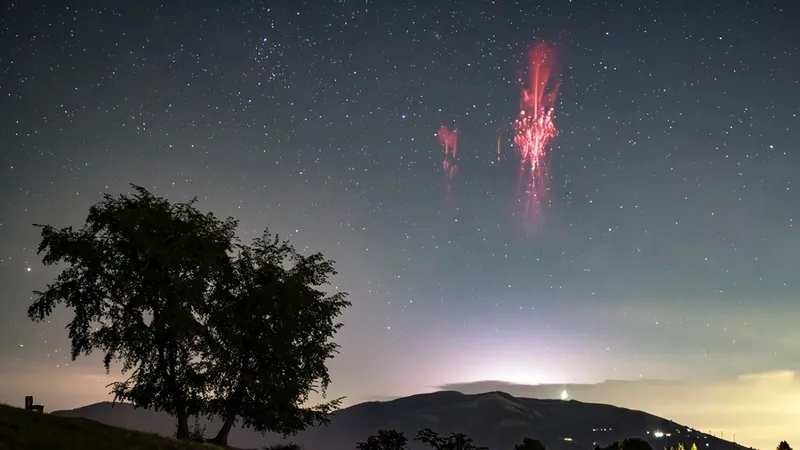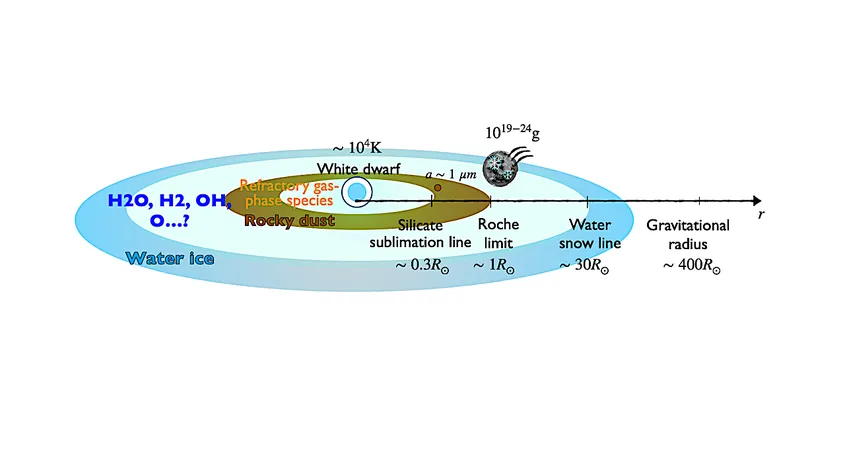
Revolutionary Discovery: Young Star's CO₂-rich Disk Shakes Up Planet Formation Theories
2025-08-29
Author: Yu
A Stunning Breakthrough in Astronomy
In an extraordinary twist in space science, a team led by Jenny Frediani from Stockholm University has unveiled a planet-forming disk around a young star, teeming with an unexpected abundance of carbon dioxide (CO₂). This groundbreaking finding, spotted using the cutting-edge James Webb Space Telescope (JWST), not only defies common beliefs about the chemical make-up of planetary nurseries but also raises intriguing questions about how planets might form in the future.
Challenging Conventional Wisdom
Typically, nearby planet-forming disks are enriched with water vapor in their inner regions. However, this newly discovered disk presents a shocking contrast with minimal water detection—an astounding twist that could reshape the narrative of planet genesis. "Water is so scarce in this system that it's barely detectable," Frediani states, emphasizing the unusual conditions present.
Redefining Planet Formation Processes
Within the conventional scope of planet formation, icy pebbles laden with water drift from the cold outer regions of a disk toward warmer zones, where rising temperatures cause them to vaporize. This process usually results in a strong signature of water vapor, yet the JWST/MIRI spectrum detects a perplexingly robust signature of CO₂ instead. "This is a significant challenge to our existing models of disk chemistry and evolution," Frediani elaborates.
The Role of Stellar Radiation
Arjan Bik, also from Stockholm University, highlights the implications of this finding, noting that the high levels of CO₂ could suggest the influence of intense ultraviolet radiation—potentially from the host star or adjacent massive stars—altering the disk's chemistry. This idea introduces a fresh perspective on how radiation environments reshape the components crucial for planet formation.
Isotopic Clues Unveiled
The research team also discovered rare isotopic variants of CO₂, enriched with carbon-13 and unique oxygen isotopes (17O and 18O), observable in the JWST data. These isotopologues may hold crucial insights into the puzzling isotopic signatures commonly found in meteorites and comets, potentially connecting this research to the broader story of our own solar system's origins.
Vast Cosmic Distances
This CO₂-rich disk is located within the magnificent NGC 6357 star-forming region, approximately 1.7 kiloparsecs (around 53 trillion kilometers) from Earth. The pivotal discovery was made by the eXtreme Ultraviolet Environments (XUE) collaboration, an initiative focused on understanding how harsh radiation fields influence disk chemistry.
The Bigger Picture
Maria-Claudia Ramirez-Tannus from the Max Planck Institute for Astronomy emphasizes the importance of this discovery, stating it showcases how extreme radiation environments prevalent in massive star-forming areas can alter the fundamental building blocks of planets. As most stars—and likely most planets—form in similar regions, grasping these dynamics is vital for comprehending the vast diversity of planetary atmospheres and their potential to support life.
A New Age of Astronomical Research
Thanks to JWST's advanced MIRI instrument, astronomers can scrutinize distant, dust-enshrouded disks with unprecedented clarity in the infrared spectrum, revealing the physical and chemical conditions that govern the birth of planets. As researchers continue to compare these energetic environments with quieter zones, a more nuanced understanding of the factors shaping planetary systems is emerging.
Innovation in Observation Technology
Astronomers at both Stockholm University and Chalmers played a crucial role in developing the MIRI instrument, which operates in mid- to long-wavelength infrared radiation ranges from 5 to 28 microns. With specialized coronagraphs to observe exoplanets, this technology stands at the forefront of modern astronomical research.



 Brasil (PT)
Brasil (PT)
 Canada (EN)
Canada (EN)
 Chile (ES)
Chile (ES)
 Česko (CS)
Česko (CS)
 대한민국 (KO)
대한민국 (KO)
 España (ES)
España (ES)
 France (FR)
France (FR)
 Hong Kong (EN)
Hong Kong (EN)
 Italia (IT)
Italia (IT)
 日本 (JA)
日本 (JA)
 Magyarország (HU)
Magyarország (HU)
 Norge (NO)
Norge (NO)
 Polska (PL)
Polska (PL)
 Schweiz (DE)
Schweiz (DE)
 Singapore (EN)
Singapore (EN)
 Sverige (SV)
Sverige (SV)
 Suomi (FI)
Suomi (FI)
 Türkiye (TR)
Türkiye (TR)
 الإمارات العربية المتحدة (AR)
الإمارات العربية المتحدة (AR)